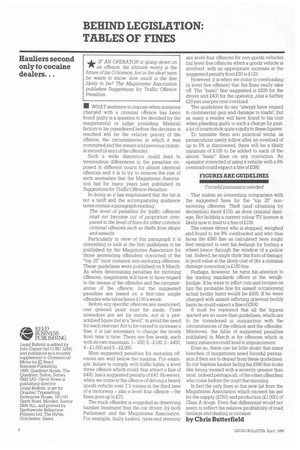Hauliers second only to cocaine dealers. . .
Page 114

If you've noticed an error in this article please click here to report it so we can fix it.
WHAT sentence to impose when someone charged with a criminal offence has been found guilty is a question to be decided by the magistrate(s) or judge presiding. Material factors to be considered before the decision is reached will be the relative gravity of the offence, the circumstances in which it was committed and the means and previous criminal record (if any) of the offender.
Such a wide discretion could lead to tremendous differences in the penalties imposed in different courts for almost identical offences and it is to try to remove the risk of such anomalies that the Magistrates Association has for many years past published its Suggestions for Traffic Offence Penalties.
In doing so it has emphasised that the list is not a tariff and the accompanying guidance notes contain a paragraph reading: The level of penalties for traffic offences must not become out of proportion compared to the level of fines for other common criminal offences such as thatis from shops and assaults Particularly in view of this paragraph it is interesting to look at the first guidelines to be published by the Magistrates Association for those sentencing offenders convicted of the "top 25" most common non-motoring offences. These guidelines were published on 9 March. As when determining penalties for motoring offences, magistrates will have to have regard to the means of the offender and the circumstances of the offence, but the suggested penalties are based on a first-time single offender who takes home £150 a week.
Before any specific offences are mentioned, one general point must be made. Fines nowadays are set by statute, not at a prescribed figure but at a "lever, to avoid the need for each relevant Act to be varied to increase a fine; it is just necessary to change the levels from time to time. There are five levels, each with its own maximum: 1£50; 2£100, 3£400, 4 £1,000 and s-2,000.
Most suggested penalties for motoring offences are well below the maxima. For example, failure to comply with traffic lights, a level three offence which could thus attract a fine of £400, has a suggested penalty of £40. However, when we come to the offence of driving a heavy goods vehicle over 7.5 tonnes in the third lane of a motorway also a level four offence the fines goes up to £75.
The truck offender is regarded as deserving harsher treatment than the car driver, by both Parliament and the Magistrates Association. For example, faulty brakes, tyres and steering are level four offences for non-goods vehicles but level five offences when a goods vehicle is involved, with an appropriate increase in the suggested penalty from £50 to £125.
However, it is when we come to overloading (a level five offence) that the fines really take off. The "basic" fine suggested is £200 for the driver and £400 for the operator, plus a further £20 per one per cent overload.
The guidelines do say "always have regard to commercial gain and damage to roads", but as many a reader will have found to his cost when pleading guilty to such a charge by post, a lot of courts stick quite rigidly to these figures.
To translate them into practical terms, as prosecutions rarely follow after an overload of up to 5% is discovered, there will be a likely minimum of £100 to be added to each of the above "basic" fines on any conviction, An operator convicted of using a vehicle with a 9% overload could expect a fine of £580.
FIGURES ARE GUIDELINES Forceful persuasion needed That makes an interesting comparison with the suggested fines for the 'top 25" nonmotoring offences. Theft (and obtaining by deception) merit £150, as does criminal damage. Not holding a current colour TV licence is likely now to lead to a fine of £100.
The owner-driver who is stopped, weighed and found to be 9% overloaded and who thus faces the £580 fine as calculated here might feel tempted to vent his feelings by hurling a wheel-brace through the window of a police car. Indeed, he might think this form of therapy is good value at the likely cost of (for a criminal damage conviction) a150 fine.
Perhaps, however, he turns his attention to the trading standards officer at the weighbridge. If he were to inflict cuts and bruises on him the probable fine for assault occasioning actual bodily harm would be £300. If he were charged with assault inflicting grievous bodily harm he could expect a fine of £500.
It must be repeated that all the figures quoted are no more than guidelines, which are to be considered in conjunction with the circumstances of the offence and the offender. Moreover, the table of suggested penalties published in March is for offences which in many instances could lead to imprisonment.
Even so, there can be little doubt that many benches of magistrates need forceful persuasion if they are to depart from these guidelines. So our hapless haulier facing his £580 fine looks like being treated with a severity greater than most, indeed perhaps all, of the other offenders who come before the court that morning.
In fact the only fines in this new list from the Magistrates Association which exceed his are for the supply (£750) and production (£1,000) of Class A drugs. Even that differential would not seem to reflect the relative profitability of road haulage and dealing in cocaine!
by Chris Butterfield
















































































































































